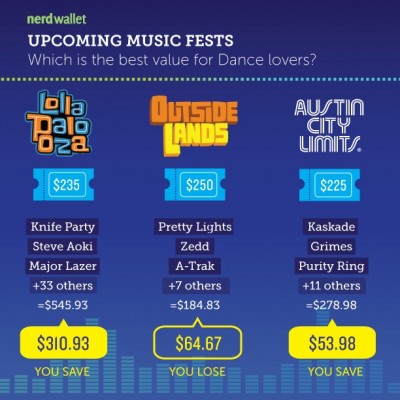When music fans talk summer festivals, we love to argue: Which is the best deal?
Normally, we take a qualitative approach to this question: Paul McCartney’s a legend, Azealia Banks is so last year, Pretty Lights puts on the best light show.
We at NerdWallet approached this question from a different perspective: the impact on your wallet – a festival ticket’s dollar value to you, the consumer. For fans of dance music, we found the winner is far and away Lollapalooza. All in all, Lolla’s such a good deal for dance fans that you end up saving $310.93 on that $235 three-day pass.
You may have already danced ‘til you dropped at EDC or Ultra this spring and summer, but if you’re hungry for more, take note of what you’re really paying for at these three music festivals. Outside Lands, for example, is it worth the cost if you’re in it just for dance music.
Make the right choice with your wallet
We conducted this study to help readers make better decisions with their wallet. In this case, we recommend that electronic-music fans go to Lollapalooza. In terms of sheer number, there’s more to dance to in Chicago than there will be in San Francisco the weekend after or in Austin a couple months later. At Lollapalooza, you can see as many as 36 dance bands – that’s a third of the entire lineup!
Music fans at Outside Lands may have to look beyond the electronic acts, or else they actually lose money on that $250 ticket. It’s easy to recoup the cost, though, if you’re open to seeing some of the other high-value artists on the bill, like Paul McCartney, whose show is valued at an average $154.33.
Methodology
We limited our analysis to Lollapalooza, Outside Lands and Austin City Limits because all three are coming up in the next couple months, and they all offer three-day passes at comparable prices.
To arrive at a final, net value for each festival, we subtracted the price of a three-day pass from the gross value of dance bands playing. At Lollapalooza, for example, this meant summing up the value of acts like Steve Aoki, Flux Pavilion, Dada Life and a number of others.
Gross value of dance acts – Ticket price = Net value
Of course, you can’t see every one of the dance bands on the lineup, because there’s inevitably overlap, so we assumed that dance-music fans would see the higher-value (i.e. more popular) act when those conflicts did occur. This meant, for example, that, at Lollapalooza, our dance-music fan wouldn’t see newcomer Disclosure – they’d opt for dance-music godfathers New Order, who go on stage at the same time.
Generally, in estimating the value of each festival, we simulated the festival experience of your typical concert-goer. Further detail on that simulation and our methodology is below:
- We compiled ticket prices for each artist’s upcoming shows or most recent shows and averaged those prices to find the act’s average value. Where available, we included service fees as well. This pricing information was collected from Ticketmaster, Live Nation, Ticket Web and Ticketfly, among other venues.
- For festivals that had not yet released their schedules, we projected 2013 set times with those of the previous year. This method is in keeping with the following rule of thumb at festivals: more popular bands, who are higher on the bill, play later in the day and on the main stages. We thus compared festival ranking from 2012 to 2013 to predict 2013 set times for Outside Lands and Austin City Limits.
- Where scheduling conflicts occurred, we assumed that our festival-goer would see the higher-value acts on the lineup.
- For some ticket-pricing information, for shows held before 2013, we adjusted for inflation. Nine Inch Nails’ last performance, for example, was in 2009.
- We assumed that a headlining show, on average, is one-and-a-half hours long, and so we adjusted the value of a festival set accordingly. A one-hour set at the festival meant a lesser value than that of their regular headlining shows.
- We categorized bands as dance acts with genre information collected from Wikipedia, allmusic, and last.fm. Therefore, artists that fell into the following categories were considered in this analysis: Brostep, Club, Dance, Dance-Punk, Dancehall, Deep House, Drum & Bass, Drumstep, Dubstep, Dutch House, EDM, Electro, Electro House, Electro-Techno, Electronic, Electronic Rock, Electronica, Electropop, House, IDM, Indie Electronic, Indietronica, Italo Disco, Mashup, Moombahcore, Moombahton, Progressive House, Synthpop, Tech House and Techno.
The bands we considered and the value of their show
With the genre frame detailed above, we analyzed the value of the following artists at each festival. Less clear-cut dance artists – including Yeah Yeah Yeahs, Atoms for Peace and Tegan & Sara – were included in this analysis because 1) one or more of their listed subgenre classifications fit our criteria for dance music and 2) these artists have produced veritable electronic-dance music: take the former’s “Zero” for example, or the latter’s “Closer”.
Keep in mind that the values below are the value of a full, headlining show, which you’d usually see at a club or arena. To calculate the value at the festival, all you have to do is use this simple formula:
Value at headlining show * (Length of festival set/Length of headlining show) = Value at festival
We assume that third variable, the length of a band’s headlining show, to be an hour and a half. So, for example, Ellie Goulding’s show at Lollapalooza isn’t worth the full $40.47 listed below; for her hour-long set, you get a $26.98 value.
| Lollapalooza | Outside Lands | Austin City Limits | |
| Gross Value | $545.93 | $184.83 | $278.98 |
| Ticket Price | $235.00 | $249.50 | $225.00 |
| Net Value | You save $310.93 | You lose $64.67 | You save $53.98 |
| Note: The math above works out like this: Gross value of dance artists – Ticket price = Net value. In calculating the gross value, we took into account that, because of scheduling conflicts, a festival-goer couldn’t see every dance act on the lineup. | |||





